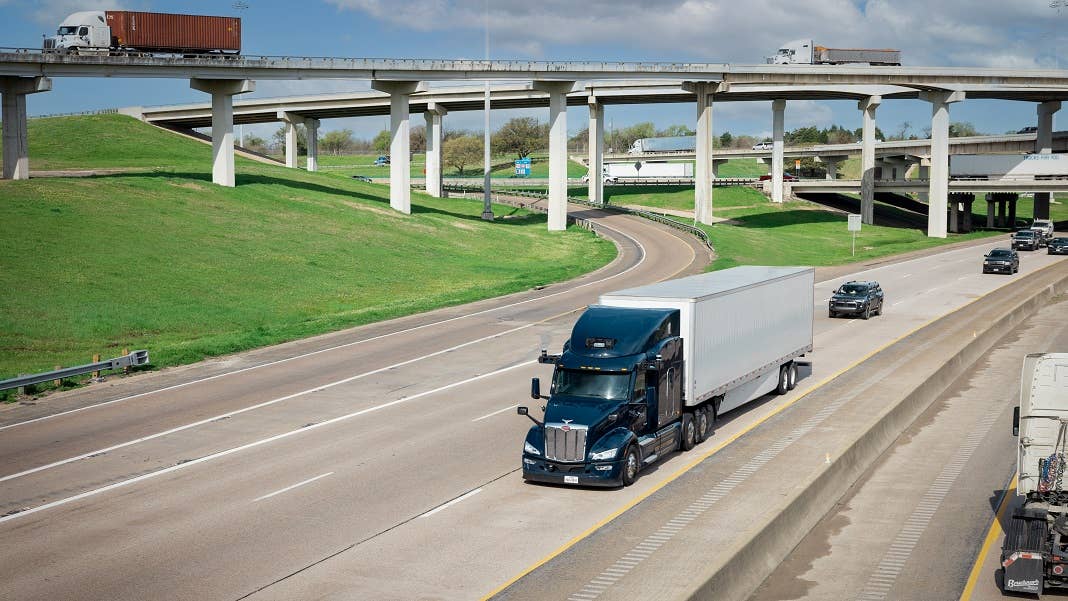Autonomous Trucks Will Be Cruising Down Highways Next Year, Startup Says

Share
Self-driving cars get all the hype (or, they did before people realized they weren’t going to be ready by 2020…or 2022…or this year), but self-driving trucks are likely to hit the road first. Not only is the bulk of their driving done on highways, which is far simpler than navigating urban roads with all their obstacles; there’s been a shortage of truck drivers for years, and it doesn’t seem to be getting better, so there’s a market need for trucks that can drive themselves.
If one company’s plan plays out, trucks without drivers will be cruising down highways by next year. On Monday driverless hardware and software specialist Aurora Innovation announced that its Aurora Driver—a system of sensors, software, and a computer designed to give any vehicle self-driving capabilities—is “feature complete.” This means all the product’s technical capabilities are in place and it’s entering its final phase of development. The company is planning to launch the Driver commercially next year.
The current version of the product is Beta 6.0, and it’s specifically built for service on Aurora’s Dallas to Houston route, which is one of the most highly trafficked shipping corridors in the country. At 240 miles long, the route is mostly a straight shot on Interstate 45, and made up the initial run of an autonomous freight pilot Aurora did with FedEx (they subsequently added a 600-mile route between El Paso and Fort Worth).
As a company press release explains, the main difference between Beta 6.0 and its predecessor is the system’s improved ability to handle uncommon road scenarios that impact safety, like high winds, collisions, or sudden heavy rain, snow, or fog. Beta 6.0 can detect the severity of these conditions and either slow down or look for a safe place to pull over. If a vehicle does get in an accident, the system is trained to pull over and alert one of the company’s command center specialists. In addition, Aurora worked with Waymo to design a flashing beacon that alerts oncoming traffic when one of its trucks is pulled over on the side of the road.
Aurora was founded by industry veterans Chris Urmson, who previously led Waymo; Sterling Anderson, who oversaw Tesla’s autopilot program; and Drew Bagnell, who worked on Uber’s self-driving program. The company’s 2019 funding round raised more than $530 million, with Amazon being one of the main investors. The company has partnered with major automakers like Volvo, Volkswagen, Toyota, and Hyundai, among others. In 2020, Aurora acquired Uber's self-driving unit, and in 2021 went public via a $13 billion special-purpose acquisition company (SPAC) deal with Reinvent Technology Partners. Subsequently, though, its stock fell by more than 85 percent.
Be Part of the Future
Sign up to receive top stories about groundbreaking technologies and visionary thinkers from SingularityHub.


Urmson’s optimism seems unshakable, though. “We look at trucking, and we see a landscape where we feel like [we’re] the only viable player,” he recently told Fast Company. “It’s an $800 billion business in the US, and we’re a company that is well capitalized, that’s got incredible talent, amazing partnerships, and awesome technology. We’re like, ‘Let’s just go execute.’i”
Now that Aurora Driver’s architecture is complete, the company will shift its focus to closing its Driver Safety Case, outlining its approach to safety and demonstrating that vehicles equipped with its self-driving system are safe to be on public roads. The US Department of Transportation requires this documentation before the company can commercially launch its product.
If all goes to plan, trucks outfitted with Aurora Driver will be cruising the Houston-Dallas corridor a year from now. Ultimately the goal is to lighten the burden on truckers and give the freight industry a needed boost, improving efficiency and economic feasibility across the board.
Image Credit: Aurora Innovation
Vanessa has been writing about science and technology for eight years and was senior editor at SingularityHub. She's interested in biotechnology and genetic engineering, the nitty-gritty of the renewable energy transition, the roles technology and science play in geopolitics and international development, and countless other topics.
Related Articles

This Light-Powered AI Chip Is 100x Faster Than a Top Nvidia GPU

This Week’s Awesome Tech Stories From Around the Web (Through December 20)

Data Centers in Space: Will 2027 Really Be the Year AI Goes to Orbit?
What we’re reading